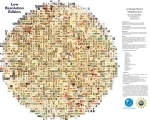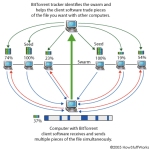Michael Lang, John Roberts, Joel Rosenman, and Artie Kornfeld, Woodstock Festival (1969)
—
Our classification matrix, as all arrays, has to be fully satisfied. We have now one last case to be analyzed: the designer active in the “all for all” case.
The “all for all” case in particularly difficult because it is not so easy to find situations where large quantities of undifferentiated people work for the benefit of … other large groups of people. A quick analysis shows that within these masses you always (well, almost always) have defined power structures controlling, channeling and guiding the work of the “all”.
Fiesta of San Fermin in Pamplona, Navarra, 2007. That’s the world’s famous, annual bullfighting party, brought to fame in 1926 by the then lesser known author, Ernest Hemingway, in his novel: “The Sun Also Rises”.
—
Although we all know several examples of this kind (Woodstock rather than the big football game in the European Champions League or the like), it is pretty clear that this mass has to be channeled, organized, motivated and so on.
Francesc Mitjans Miró, Lorenzo García Barbón, Josep Soteras Mauri, “Camp Nou“, Barcelona, 1957
—
Once this said, we can agree that the process of organizing a football match at Barcelona’s Camp Nou is inherently different from the organization of the Nazi rally in Nuremberg in 1934 (as rendered by Leni Riefensthal in “Triumph of the Will“, 1935).
Screenshot from: Leni Riefensthal in “Triumph of the Will”, 1935.
—
FC Barcelona is an atypical football company, owned by 170,000 shareholders who are the same people who fill the stands of the stadium during the season. To the eye, the final effect (product) is similar to what we saw two years ago at the opening of the Beijing Olympics stadium. Obviously, being an happy fan and shareholder of the Catalan crowd is quite different than being a pawn directed and commanded by the Chinese Communist Party propaganda apparatus.
Beijing Olympic Games, Opening Ceremonies, 2008
Woodstock Festival (1969), original billboard
—
Even if the digital world, the category of “everyone for everyone” looks to be essentially empty.
This is the case of online collaborative environments (Wikipedia being the classic, but the same could be said of Amazon where readers can significatively contribute with their reviews). On this subject Jakob Nielsen reminds us of an empirical law that can be summed up as: “90/9/1”: 90% of users use the information but don’t contribute, 9% contribute occasionally, and 1% contribute very often. If you check the datas, the majority of contributions in system like Wikipedia or the like (articles, reviews, postings…) is made by the 1% of users.
The distribution becomes more unbalanced (95/5/0.1) if we talk about blogs. In front of (over) a billion Internet users (who read) there are only 55 million blogs (5% of all Internet users). However, there is only a 0.1% who writes every day on his blog.
In the case of Wikipedia, the distribution becomes closer to 99.8/0.2/0.003 (much more extreme).
How do you keep track of the bubbling mass of information that is Wikipedia? This chaotic-looking mosaic is one attempt to show which topics are contained in the online encyclopedia, and those most hotly contested. (Bruce Herr, Todd Holloway, 2007)
—-
As explained before, to get very close to the “all for all” system we should look within the various folk and religious festivals like the Carnival of Oranges in Ivrea, or the bull race in Pamplona or the complex mechanisms behind the organization of Palio in Siena (where the whole city is involved in the year long preparation, followed by the incredible celebrations if your “contrada” wins).
Carnevale di Ivrea (the battle of oranges)
—
Or even closer to the true meaning of “all for all” is the typical example of political rallies where large masses of people are together to multiply their strength and the communication of their values. The fall of the Berlin Wall is paradigmatic in this sense (the kind of operation where the final result could be accomplished only by “all” the people). Of course, like any other project belonging to the previous families, also within this category you do not always reach the desired final result (Tien-An-Men carnage for all), or generate unexpected consequences.
The fall of Berlin’s wall, 9th November 1989
—
Nicolae Ceausescu goes to the balcony for what will be his last speech in front of the huge Rumanian crowd. He is working on the “one for all” system, hoping to trigger enough enthusiasm and energy to transform the whole rally into a galvanizing “all for all” moment. Horribly (for him), everything takes an unexpected swing and the whole rally transforms itself into “all against one”, with the dire consequences (for Ceausescu) we remember.
Nicolae Ceauşescu flees Bucharest by helicopter on December 22, 1989
—
It is nice to finish this chapter pointing to the well-know example of on-line anonymous altruism (also called: pirate file sharing). Using a protocol like BitTorrent, for example, there is the possibility to force the user to share his files, and to limit his ability to download data in proportion to his offer (basically a forced “do ut des”).
BitTorrent: how does it work?
—
Curiously, The Pirate Bay (the largest BitTorrent server), has no control over what users upload and download, and relies on the “good heart” of people. The rules of the game, however, are partly dictated by the interface design (if the interface makes it easier to share data a great number of non-technical user will share them not because of altruism but simply as a default choice).
The available numbers do suggest this policy: in this moment (12.24 GMT on 01/18/2010), The Pirate Bay backs over two million files shared by 22,078,666 users out of which 12,577,018 have finished downloading and are just sharing their (purely altruistic behaviou); with 9,501,648 users downloading and uploading data at the same time (mixed behavior). This means that we have more than half of people acting completely altruistically.
The typical pirate activity processed via Internet (and you reading these note could easily be within this category), contains many elements of interest to the designer: it shows us that altruism (if there were doubts about it) is likely when it is easy and passive, while it becomes not-s0-likely when the choices are multiple and it requires a visible commitment of resources.
The Pirate Bay homepage
—
Name and things useful + important (to be remembered for the exam):












